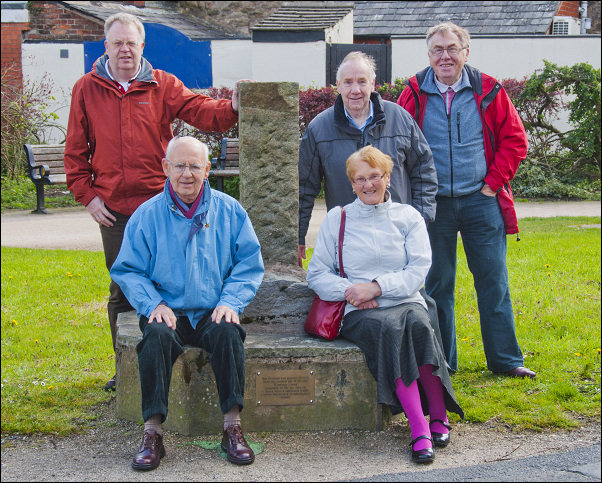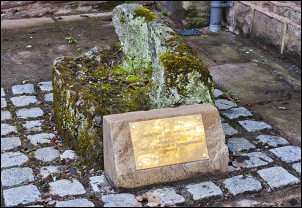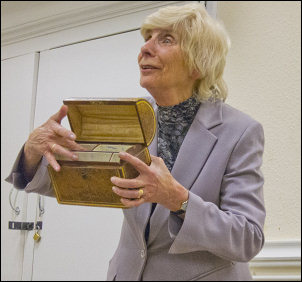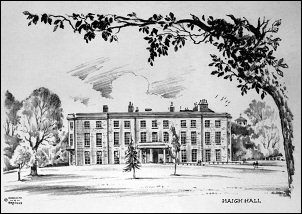|
|
|
|
|
Apr 2012 |
|
|
|
The replica
weeping cross site at Cheapside / Gillibrand Walks, Chorley
Sat 28 April 2012 |
|
Chorley
Historical and Archaeological Society have recently erected
information plaques at three locations in the Chorley area. They
mark the positions of ancient crosses and a replica cross was
fixed at one location in Chorley at the junction of Cheapside
and Gillibrand Walks. The site was documented 1836 and a later
description said
“ .. It was a roadside or 'weeping' cross where funeral
processions halted that prayers might be said for the departed
soul.”
Society members gathered on Saturday morning to celebrate the
fixing of the plaques.
The two others are at Euxton Parish Church where an actual cross
base stone remains and Ollerton Fold where a replica cross has
been erected near the site of the original cross.
Wayside crosses were a common sight in early 16th century
England. They were a location where people would rest and pray
and with funerals the burial party would stop to allow the
coffin bearers to rest on their way to the burial ground.
Some crosses were referred to as weeping stones if they were
used by funerals. After the English Reformation in the 16th
century when the Church of England broke away from the control
of Rome and the Catholic faith the crosses and weeping stones
fell into disuse. As they had religious associations they were
sought out and many removed. Although many crosses were
destroyed the stone bases often remained. Many of the bases have
also gone but early maps and documents recorded their positions.
The Society would like to thank Chris Livesey of B.Livesey Ltd
for providing the information plates. |
|

The replica weeping cross at Cheapside / Gillibrand Walks,
Chorley |
|

Replica Cross at Ollerton Fold |

The Cross base at Euxton Parish Church |
|
|
Visit to
Lancashire Archives at Lancashire Records’ Office
Wednesday, 18 April 2012 |
A group of members made their
way to Bow Lane, Preston for 7.00pm for a guided tour of the
county’s archives. We were met by a county archivist, Kathryn
Rook, who was going to be our guide for the 90 minute tour.
As an introduction Kathryn had laid out on tables, examples of
items that are stored in the archives. These included items with
a leaning towards Chorley, such as St Laurence’s parish
register, archaeological reports, examples of wills and poor law
maps.
We were free to examine these items and ask Kathryn any
questions we had about them.
Kathryn’s formal introduction explained that the Lancashire
Archives is probably one of the largest in the country and was
started in the 1940’s. There is no law that stipulates that any
particular authority has to hold an archives store. Initial
deposits into the archives included landed gentry records and
court records. In fact, all items stored have been given to the
archives.
The present building was built in the 1970’s and included 4
strong rooms with 4 miles of shelving. As this storage space
filled up an extension was built in the 1980’s doubling the
number of strong rooms and shelving space. This storage space,
in turn, has been filled and space for any further additions has
to be accommodated by the disposal of items.
The archives’ hold records from the geographical area of post
1974 Lancashire and the policy is to store unique records. So,
there are no newspapers and birth and death certificates as
records of these are stored elsewhere.
The oldest item dates from 1140 but there are many documents
from later in the century. Items’ stored include 300,000 wills
and parish registers dating from 1550 to 1858, property records,
land tax records and quarter sessions courts’ records.
Kathryn explained the process that anyone has to go through in
order to search the records. There is an online catalogue but
people can write in, phone in or visit the archives in person.
Items are stored on microfiche and microfilm and there are
numerous machines on which to view them. They also offer free
access to ancestry.co.uk there too.
She took us into the secure archives section produced several
wonderful 19thC tithe maps of the Chorley area from banks of
presses. These had everyone inspecting the closely.
Then we were taken down to one of the temperature controlled
storerooms and showed us further gems in the collection. These
included a beautiful example of a book from the 1550’s and 2
extraordinary charters on parchment, one dating from 1199 and
one from the 1600’s. The early one was from King John that gave
hunting rights to forest dwellers in an area of present day
Lancashire. The other charter was from Queen Elizabeth 1 that
was taken to China with the aim of improving trade links.
Kathryn, who clearly has a passion for what is stored in the
archives, gave us a wonderful insight into what is kept there
and encouraged everyone to return in the future to explore
further.
Peter Robinson
letters from Charles Dickens and scripts from the Z-Car tv
series. |
|
|
Carole Banks –
Haigh Hall and the People Who Lived There
Tue 10 Apr 2012 |
|
Carole
explained that she first encountered Haigh Hall as a subject
matter when she was a schoolteacher at Aspull. She taught Year 6
children in the years before the National Curriculum and
obtained the 1871 census for Haigh Hall as part of a project.
Later, after presenting a talk on the subject to a local church
group, she was invited to give it to another group and so it
snowballed. |

Carol Banks |
|
The place name
of Haigh is Anglo-Saxon name and means the place of an
enclosure. Carole’s starting point in history is 1066 and the
Norman invasion of England. The area covered roughly by the pre
1974 Lancashire boundary was granted by King William to one of
his kinsmen. By the 13thC the area had been sub-divided and the
area that included Haigh came under the Lord of the Manor of
Newton. It is noted that a record from this time states that a
Hugh Norris built the first house at Haigh. |
 |
|
It is Hugh
Norris’s granddaughter, Lady Mabel, who is surrounded by legend.
She married a William Bradshaigh (Bradshaw) from West Leigh but
he had to go away to fight. After time news came to Lady Mabel
that her husband had been killed in battle. Following this news
she later married a Welsh knight. It came to pass, however, that
she received a shock visit from her very much a live William.
Consequently, William slew the Welsh knight. Mabel lived on with
William. As a form of penance for her unintentional bigamy she
was said to have made a weekly bare footed walk from the hall to
the cross on Wigan Lane. The cross is still there but is known
as Mab’s cross.
Haigh Hall’s estate had the good fortune to have sufficient
quantities of a good quality of coal to make the estate
profitable. From the 16thC onwards this coal was exploited
successfully. |
 |
|
 |
|
In the late
18thC, with no heirs, Haigh Hall passed to an impoverished lord,
Alexander Dalrymple, who had been for a few years the governor
of Jamaica. He did, though, see the potential for coal mines on
the estate and the canal that passed through it. He founded the
Haigh Iron Foundry that produced parts of the Laxey Wheel, Isle
of Man and iron work at Albert Dock, Liverpool.
His son, James, took on the rebuild of the hall, the present
house, which took 20 years but swept the old one away.
His son, Alexander, was the incumbent at the time of the 1871
census, which started Carole’s interest in the hall. On the
night of the census not only was the family present in the hall
but also 32 ‘living in’ servants. |

Haigh Hall in 1832 |
|
A royal visit
to Wigan took place in 1873 to open the new infirmary. It was
natural the visitors would stay at Haigh Hall and in preparation
for them £80,000 was spent on a complete refurbishment.
The early 20thC saw the 27th Earl, David, become MP for Chorley
at the age of 21. When he took the title of Lord Crawford he
moved to the House of Lords. When David died in 1940 his son,
Robert, decided to sell the hall and land to Wigan council for
£18,000. However, there was no endowment and anything the family
did not want was auctioned off.
Carole produced a couple of items sold at that auction, a wooden
writing box and an embroidered Italian hand made shawl.
Carole explained that the present earl lives mainly in Scotland
and is still a member of the House of Lords. This concluded an
enlightening evening presented by an excellent speaker.
Peter Robinson |
|
|
|